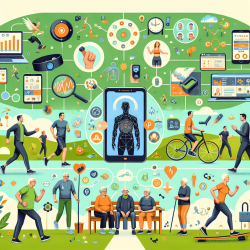Introduction
In the rapidly evolving field of healthcare, smart technology has emerged as a promising tool for enhancing physical activity among older adults. A recent systematic review and meta-analysis titled "Interventions Including Smart Technology Compared With Face-to-face Physical Activity Interventions in Older Adults" provides valuable insights into the effectiveness of these interventions. This blog explores the findings of this research and discusses how practitioners can leverage these insights to improve therapy outcomes, particularly in the context of online therapy services like those offered by TinyEYE.
Key Findings from the Research
The study included 19 randomized controlled trials with a total of 3,455 participants, comparing interventions that included smart technology components with traditional face-to-face physical activity interventions. The primary outcomes measured were physical activity levels and physical function, with secondary outcomes including depression, anxiety, and health-related quality of life.
- Smart technology interventions resulted in an average increase of 1,440 steps per day compared to face-to-face interventions alone.
- There was a significant improvement in total physical activity scores and walking, but no significant difference in moderate to vigorous physical activity.
- Smart technology alone did not show significant differences in outcomes compared to face-to-face interventions alone.
- The quality of evidence was rated as very low, indicating a need for further research to confirm these findings.
Implications for Practitioners
For practitioners, especially those involved in online therapy services, these findings highlight the potential of integrating smart technology into therapy programs. Here are some ways practitioners can apply these insights:
- Incorporate Wearables: Encourage the use of wearable activity trackers like Fitbits to monitor and motivate physical activity among clients.
- Utilize Mobile Apps: Leverage mobile health apps that provide personalized feedback and goal-setting to enhance engagement and adherence to physical activity programs.
- Combine Approaches: Consider combining smart technology with traditional face-to-face interventions to maximize effectiveness, especially for older adults who may benefit from the social interaction and accountability provided by in-person sessions.
Encouraging Further Research
While the current evidence suggests potential benefits of smart technology interventions, the low quality of evidence underscores the need for further research. Practitioners are encouraged to contribute to this field by conducting studies that explore:
- The long-term effects of smart technology interventions on physical activity and health outcomes.
- The effectiveness of different types of smart technology (e.g., wearables vs. mobile apps) in various populations.
- The impact of smart technology on secondary outcomes such as mental health and quality of life.
Conclusion
Integrating smart technology into physical activity interventions holds promise for enhancing outcomes, particularly in the context of online therapy services. By leveraging these tools, practitioners can better support older adults in achieving their health goals, ultimately leading to improved quality of life. To delve deeper into the research, you can read the original research paper by following this link: Interventions Including Smart Technology Compared With Face-to-face Physical Activity Interventions in Older Adults: Systematic Review and Meta-analysis.










